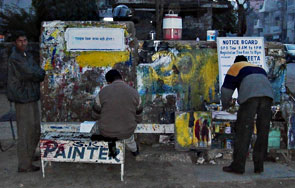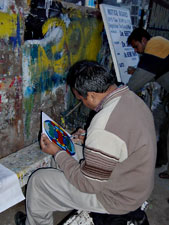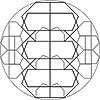| Studio | Newspaper article ! | Promotion | Modified: |
| BUILDING
THE ENVIRONMENT The process started in the beginning of January 2004 after getting familiar with the first location and practical possibilities in the neighbourhood. Sharing a main vision on interactivity made me propose Nikhil Bhardwaj a partnership on this interactive environment. Together we developed the NeuVé* concept and started to construct the environment. This interactive process between two designers continued in full speed during 4 weeks. Experiences are model for interactivity and interaction design. |
|
| Plan for the public space |
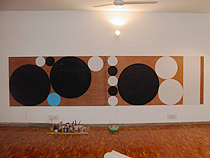 |
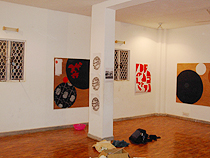 |
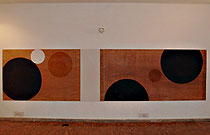 |
Nikhil was taking care of this. They would be part of environment and workshops and could be used to produce patterns or shapes on the wall.
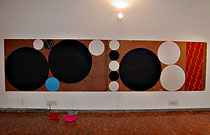 |
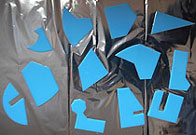 |
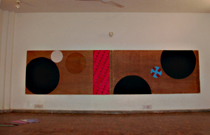 |
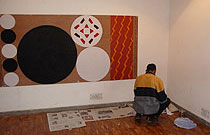 |
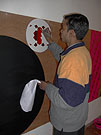 |
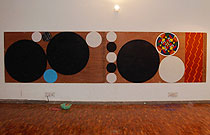 |
 |
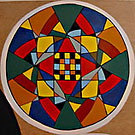 |
De sign painter wanted to have a design on paper to reproduce the compilation on the wall. Shapes were offered to him to play with but he did not want to interpret himself. After having two designs done though I think he might have tried in the end. In a next edition this could be developed to a next stage. | 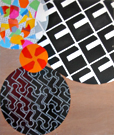 |
 |
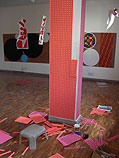 |
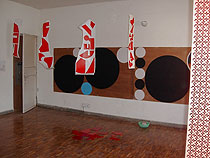 |
 |
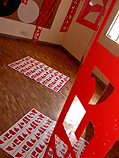 |
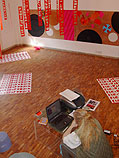 |
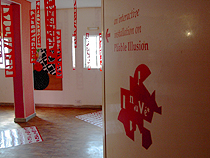 |
| As the environment
should have the atmosphere of a celebration, we decided to have stickers hanging in the space. Combining hanging and the interactive use of stickers with turned out in the use of acrylic sheets with the restforms of the stickers. The material to be used could be left on the floor as an invitation to visitors. |
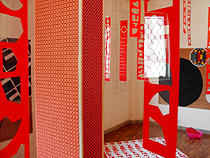 |
||
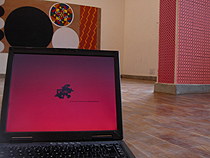 |
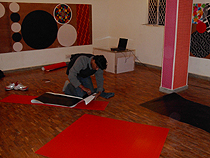 |
 |
 |
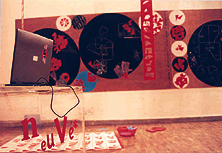 |
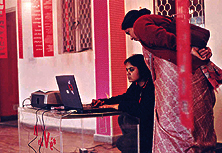 |
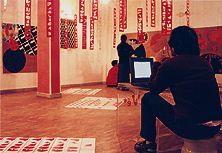 |
|
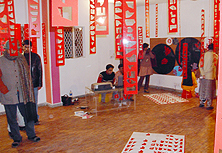 |
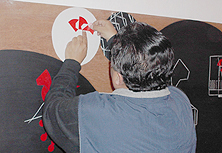 |
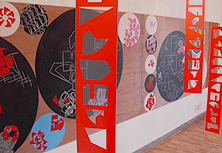 |
|
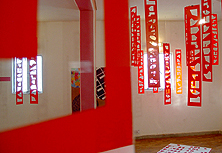 |
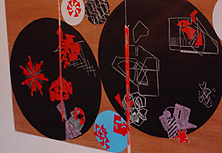 |
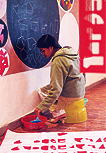 |
|
Main questions appeared: where can we find structures and patterns ? Is there a difference between them ? And can we define these ? What are the elements of the patterns ? After defining the program (Pliable Product) is presented
by projection. Eager to play with the program we decided to make that happen in the second session. The children
can play in teams with it and come to a design which will be realised in chosen material and techiniques (3 options offered). Finally the physical shapes were presented with which the children could become familiar. After some hesitation they started to play with it and ideas grew.
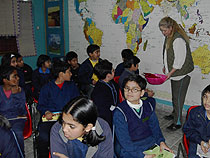 |
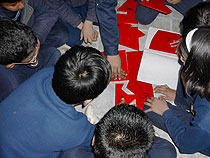 |
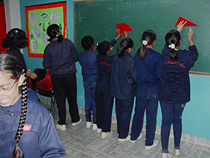 |
The 3 offered options were:
- painting, on cardboard, wood, fabrics, tile or glass.
- collage, anykind of material could be glued on cardboard or wood
- 3D-modelling in clay
Their was a great interest in 3D-modelling in clay. Special attention was put to the fact that in that case they also had to think not only about the frontside but also about the other sides of the object.
As the students were already familiar with Powerpoint and the choice of programme use was not restricted, some already started with making a small presentation on patterns and structures (This input could have been
developped in a next workshop). Sketches and final decisions were saved in My documents, as they were used to. Remarkable is the general knowledge these kids already have with the use of the computer and some existing programs.
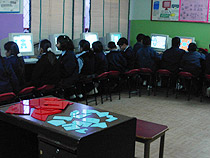 |
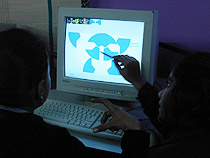 |
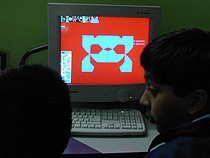 |
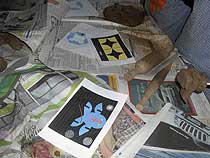 |
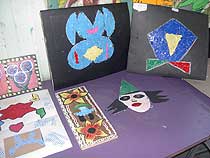 |
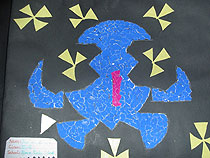 |
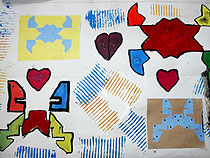 |
on tiles.
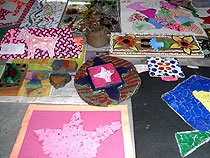 |
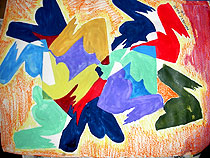 |
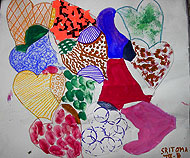 |
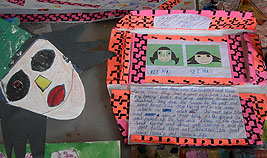 |
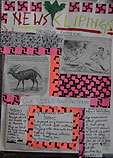 |
|
a description for a screenplay with a mask and newsclippings on the item patterns and structures.
| PREPARATION&GOAL After a week orientating about possibilities, designing on the computer and getting familiar with the pattern of Delhi-life I have started to get more concrete with material. It was already something to find out what I would need and where to get it. Some subjects, techniques and materials which have my attention are: silk, silkscreen, woodcarving, painting of signs - the design in the street (mostly handmade, as one would say in Holland). As shops were open I could order plywood on Sunday and the day after I fixed 5 sheets on the walls of the studio. |
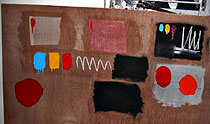 |
|
| The aim
was to realize an interactive environment which deals with circles, forms, patterns and structures in relation to the Indian culture. Interaction would consist of the cooperation between several parties in the realisation of the environment. Presenting a processlike approach in building up an environment to an Indian audience was a challenge. |
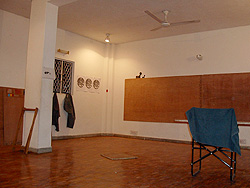 |
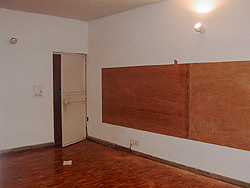 |
Structures and patterns I am strongly aware of at this very moment, especially while stepping into this
new environment. Every first thing is new, but after two, three times they are likely to become a pattern. These rhythms appear also in drawing.
Being aware of the fact that the Indian tradition of imaging is quite narrative makes a more abstract way of imaging
a challenge to see how the interaction will succeed. Some cross-cultural meetings on the communication of imaging will appear.
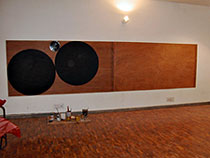 |
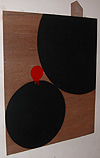 |
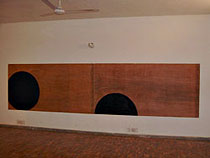 |
- myself, specialty: Dutch monumental designer, working with concepts for communication and interaction
through (visual) artefacts
- Nikhil Bhardwaj, National Institute of Design, faculty of communication design and specialised as an exhibition
designer. At present he is working as a team member on Khalsa Heritage museum project (a special museum
on the Sikh-culture, expected to be one of the biggest musea in India at the moment).
- a sign painter, specialty: nowadays tradition on producing notices etc. in Indian towns
- children from Bloom Public school and schools visiting the environment
- public during a three day presentation
- Developing the publication NeuVé* which will contain a description of the interactive process in any kind of format, like environment, installation, workshop and so on. In three languages: Hindi, English and Dutch. Meant to be distributed in India, Holland and UK to generate new interactions in public space.
- Presenting 'Volume1001 - Stad als decor' and 'Plooibaar Product - Pliable Product - Formowalny Product' to organizations to trigger opportunities on interactive projects.
